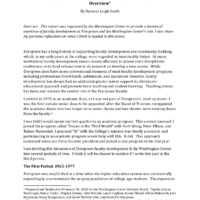The Washington Center and Faculty Development at Evergreen: An Overview
Item
- Identifier (dcterms:identifier)
- WC_Faculty_Development_final
- Title (dcterms:title)
- The Washington Center and Faculty Development at Evergreen: An Overview
- Date (dcterms:date)
- February 18, 2018
- Creator (dcterms:creator)
- Barbara Smith
